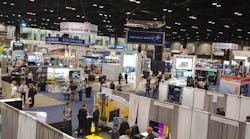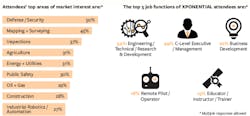Latest from Technology
Productivity and Support in Office and Field
Sponsored
Five years ago this spring, heads were turned online by futuristic flight video of a quadcopter drone delivering a pizza to the top of a skyscraper in Mumbai. Last month, a hospital in Baltimore successfully received a donor kidney suitable for transplant, dropped off by a drone designed and built collaboratively by the University of Maryland’s schools of medicine and engineering.
Such humanitarian feats of derring-do, including multiple examples of medicine delivery to disaster areas, were among those highlighted this month at XPONENTIAL 2019, the annual trade show for the Association for Unmanned Vehicle Systems International (AUVSI), held at Chicago’s McCormick Place Convention Center. The high-profile event was just the latest in the unmanned aerial system (UAS) industry’s ongoing, global marketing effort to convince both business and the general public that drones are our friends. More importantly, organizers contend, such systems are force-multiplying assets that can increase and enhance our capabilities in any number of markets.
That is still not the easiest sell, of course, as the largest contingent of the show’s 700 exhibitors this year came from the global defense industry. Booths featured unmanned applications and robotics from multiple branches of the U.S. military, as well as defense contractors. And the estimated 8,500 attendees included many military engineers from other nations, also doing research on the show floor and in several of the 100+ technical sessions held concurrently within the convention center.
For Construction Use
Even so, more construction and engineering firms continue to be drawn to drone technology. This year, some 28% of the attendees identified themselves as most interested in construction applications, up from 21% last year, according to AUVSI. Even so, the actual percentage connected to our industry could conceivably be higher, since attendees also listed “mapping + surveying“ and “inspections” among the most common uses for drones in their respective businesses.
- Source: AUVSI, May 2019
Such applications include aerial inspections of infrastructure such as wastewater treatment plants, power plants, transmission towers, pipelines, roads and bridges, etc. Unmanned systems also are used to monitor and measure heat loss, energy use, and the efficiency of entire building systems, including individual rooftop HVAC units and boilers. Using 3D laser scanning (LIDAR), data today can be gathered and analyzed in enormous volume, with extreme detail, at extraordinary speed.
"When I started at this in 1994, you could only collect 3,000 points of information in an hour, inside of a building, and then you'd have to pick up the camera and move it to the next position," recalled Chad Studer, President of NOAR Technologies, a Troy MI-based software provider and technology consultant to the AEC industry. "Today, we can scan 2 million points per second," he added.
Focused on construction work, NOAR partners with Autodesk, Bluebeam, Leica Geosystems, and Chinese camera drone specialist DJI. The data collected feeds 3D building information modeling (BIM) that informs and enhances virtual design and construction (VDC) usage, which itself continues to grow in popularity across multiple markets within our industry. (For related trends, see the results of the latest annual JBKnowldge Construction Technology Survey here.)
"Our drone team works with our VDC team to use the data to start placing equipment on jobsites in ways that allow us to coordinate faster," noted Richard Lopez, National UAS Operations Executive for general contractor Hensel Phelps, Greeley CO. "Our #1 goal on all of our sites is safety, so wherever we can do exterior inspections with drones, we will. It's safer and quicker than erecting scaffolding, and we can also make the information available more rapidly."
- Download the DroneDeploy e-book entitled, Drones in Construction Project Management.
Speaking on a panel at the event, Lopez added that regulatory hurdles limiting drone use to nighttime operations and prohibiting flights over populated areas are the only things keeping him from using UAS technology more. But AUVSI lobbying efforts this month were said to be close to winning approval from the Federal Aviation Administration (FAA) for a waiver that would permit tightly monitored flights during daytime hours, as well.
That would be well-received by vendors such as PrecisionHawk Inc., which last fall acquired Uplift Data Partners, a former drone subisidiary started by Chicago-based general contractor Clayco Inc. in 2015. Clayco retains a stake in the Uplift, and remains a customer, explained former Uplift CEO Suzanne El-Moursi, who is now PrecisionHawk's General Manager for Construction and Facilities Management. PrecisionHawk apparently sees very blue skies ahead for the market. It completed four other acquisitions last year, in addition to Uplift.
Below, a PrecisionHawk video case study from Los Angeles...
XPONENTIAL 2020 will take place next spring at the Boston Convention and Exhibition Center. For more information on upcoming AUVSI events, click here.



